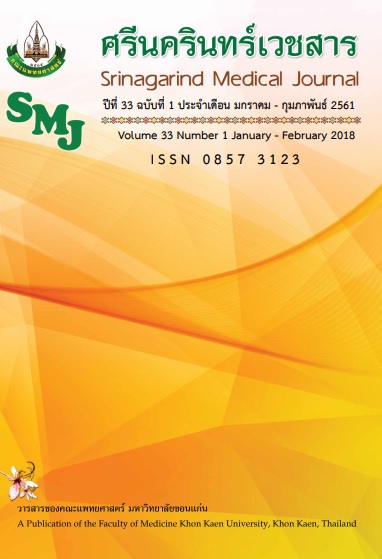Formal Assessment of Orthopaedic Trauma Surgical Skills (FAOT) for Orthopaedic Residents
Keywords:
Orthopaedic Trauma ;, Surgical SkillsAbstract
Background and Objectives: To demonstrate the process and evaluate the outcomes of the newly-developed “Formal Assessment of Orthopaedic Trauma Surgical Skills (FAOT) for Orthopaedic Residents” for evaluating Orthopaedic trauma surgical skills during orthopaedic residency training.
Methods: The FAOT assessment tool was designed and applied for the evaluation of orthopaedic trauma surgical competency of orthopaedic residents at Khon Kaen hospital, consisting of preoperative and intraoperative parts, in which 12 residents participated between November, 2015 and October, 2016. Comparisons of both pre- and post-study in-training examination scores were reported.
Results: Twelve orthopaedic residents; three of second-year, four of third-year, and five of fourth-year residents were enrolled. Each passed the minimal passing level of the preoperative parts with a mean score of 81.0. The highest and lowest scores were the description of indication for surgery, and the giving of patient information, with mean scores of 9.2 and 7.4 points, respectively. The mean score of the intra operative part was 87.7; and the highest and lowest scored parts were the operative notes report and the steps of operation, with mean scores of 18.7 and 16.4 points, respectively. The mean post-study in-training examination score (76.1 ± 8.3) was slightly higher than the pre-study (75.7 ± 9.8) with 0.47 mean difference (95% CI, -3.22 to 2.29) but there was no statistical significance (p = 0.717).
Conclusion: The FAOT assessment tool was effectively applied for the evaluation of surgical skill competency of each orthopaedic resident.
การประเมินทักษะการผ่าตัดทางการบาดเจ็บทางออร์โธปิดิกส์ของแพทย์ประจำบ้านออร์โธปิดิกส์
วันจักร พงษ์สมัครไทย*, สุธี ทระกุลพันธ์, อรุณ วรนุช, อุดมศิลป์ สิงห์แจ่ม
กลุ่มงานออร์โธปิดิกส์ โรงพยาบาลขอนแก่น
หลักการและวัตถุประสงค์: เพื่อแสดงถึงขั้นตอนในการประเมินและผลการประเมินทักษะในการผ่าตัดทางการบาดเจ็บทางออร์โธปิดิกส์ของแพทย์ประจำบ้านออร์โธปิดิกส์โดยการใช้ “Formal Assessment of Orthopaedic Trauma Surgical Skills (FAOT) for OrthopaedicResidents”
วิธีการศึกษา: นำเครื่องมือประเมิน FAOT มาใช้ในการประเมินทักษะในการผ่าตัดการบาดเจ็บทางออร์โธปิดิกส์ในแพทย์ประจำบ้านออร์โธปิดิกส์ทั้งหมด 12 ราย ในช่วงระหว่างเดือนพฤศจิกายน พ.ศ.2558 ถึง เดือนตุลาคม พ.ศ.2559 และทำการเปรียบเทียบผลการสอบในช่วงก่อนและหลังทำการศึกษา
ผลการศึกษา: แพทย์ประจำบ้านออร์โธปิดิกส์ จำนวน 12 ราย (ปี 2-4 จำนวน 3,4 และ 5 ราย ตามลำดับ) สามารถผ่านเกณฑ์การประเมินในช่วงก่อนผ่าตัดด้วยคะแนนเฉลี่ย 81.0 หัวข้อประเมินที่ได้คะแนนมากที่สุดและน้อยที่สุด คือ ข้อบ่งชี้ในการผ่าตัดและการให้ข้อมูลผู้ป่วย โดยได้คะแนนเฉลี่ย 9.2 และ7.4 คะแนน ตามลำดับ คะแนนเฉลี่ยในช่วงผ่าตัดเท่ากับ 87.7 คะแนน ส่วนที่ได้คะแนนมากที่สุดและน้อยที่สุด คือ แบบบันทึกการผ่าตัดและขั้นตอนการผ่าตัด โดยได้คะแนนเฉลี่ย 18.7 และ 16.4 คะแนนตามลำดับ ผลคะแนนสอบเฉลี่ยหลังทำการศึกษาเท่ากับ 76.1 ± 8.3 คะแนนซึ่งมากกว่าผลคะแนนสอบเฉลี่ยก่อนทำการศึกษา (75.7 ± 9.8 คะแนน) โดยมีค่าความแตกต่างของค่าเฉลี่ยเท่ากับ 0.47 คะแนน (ช่วงเชื่อมั่น 95% ระหว่าง -3.22 ถึง 2.29) แต่ไม่มีนัยสำคัญทางสถิติ (p = 0.717)
สรุป: เครื่องมือประเมินทักษะการผ่าตัดทางการบาดเจ็บทางออร์โธปิดิกส์สามารถนำมาใช้ประเมินศักยภาพด้านการผ่าตัดของแพทย์ประจำบ้านออร์โธปิดิกส์ได้อย่างมีประสิทธิภาพ




